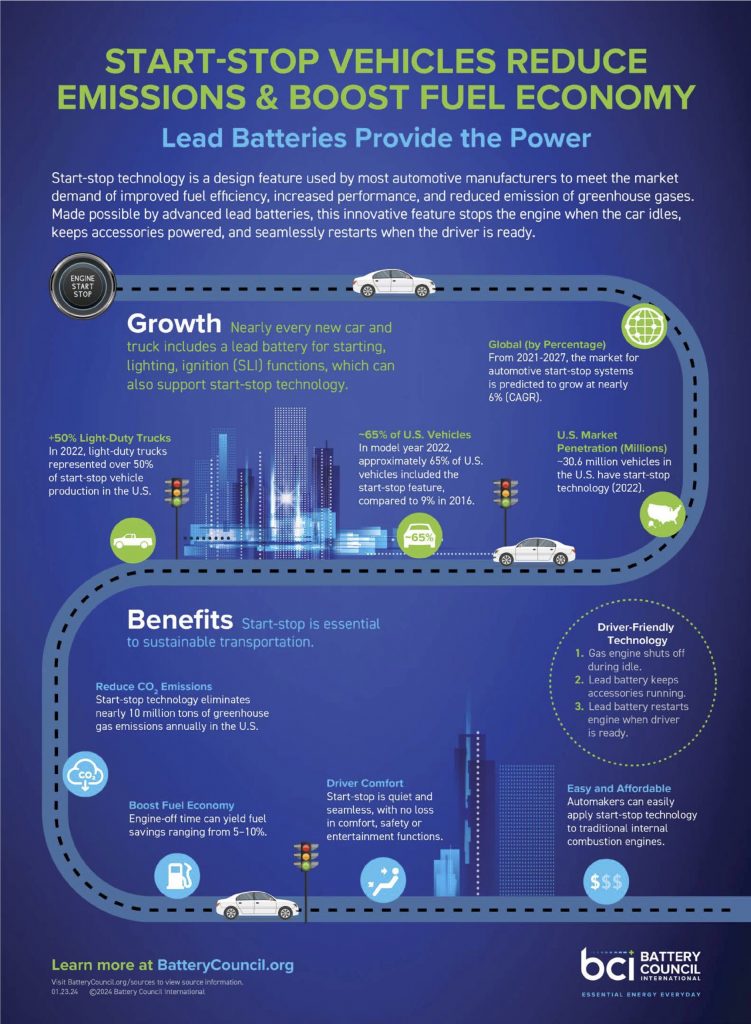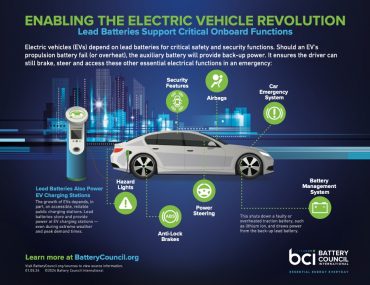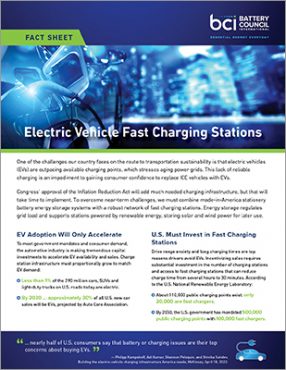
Lead Batteries Are Premier Choice for Powering This Green Feature in Hybrids and ICE Vehicles
Auto manufacturers are at a crossroads: Their electric vehicle sales are slowing. Yet government mandates and environmental regulations to reduce auto emissions – and help mitigate the effects of greenhouse gas – are increasing. What’s shrinking the divide? Start-stop technology, powered by sustainable lead batteries.
Start-Stop Technology Reduces Emissions
Lead batteries can enable significant greenhouse gas emissions for ICE (gas-powered) vehicles by allowing engines to turn off when the vehicle is on, but not moving. Automakers have long favored lead batteries for this energy efficient feature. Hybrid vehicles have always had start-stop technology.
Now, the integration of start-stop technology into the car parc is rapidly growing. In 2016, only about 9% of passenger cars had the feature. In 2022, the number grew to approximately 65% according to the 2023 EPA Automotive Trends Report.
The technology works just the way it sounds: The engine stops while the vehicle isn’t in motion and starts again when the driver presses the pedal. The benefits include:
- Fuel savings of as much as 10% over traditional ICE platforms
- Eliminating nearly 10 million tons of greenhouse gas emissions annually in the U.S.
Lead Batteries Help Bridge Transition from ICE to Full EVs
Last year, EV-volumes.com forecasted that global EV sales, comprising battery-electric vehicles and plug-in hybrids, would reach more than 14 million units in 2023. That’s a 34% increase over 2022.
Despite the ambitious goals for EV adoption in the U.S., it will likely be an evolution, rather than a revolution, as confirmed by a 2023 report by J.D. Power. It said electric vehicles account for less than 1% of the 250 million vehicles, SUVs, and light-duty trucks sold in the United States. And, because only around 17 million new cars are being built each year, changing the car parc from gas-powered to electric will be a long process, especially as far as the government is concerned.
That’s causing Ford, General Motors and Honda to rethink their EV strategies and the pace of full-EV product rollouts. The integration of start-stop technology remains essential, as automakers feel the heat to pursue low-emission fleets and meet ambitious national carbon-reduction targets.

Lead Batteries Will Continue Providing Critical Power to Full Electric Vehicles
The electric vehicle revolution is full of innovation and potential. But it’s also built on the foundations of existing car technology, including lead batteries.
Lead batteries are critical in nearly every major electric vehicle for powering the auxiliary power systems. Traditional automotive battery chemistries power windshield wipers, power windows, and a host of other important functions so the lithium-ion battery that powers the drive train can focus on that core function. They also ensure critical safety systems remain powered in the event of an issue with lithium battery packs. Lead batteries are the preferred choice for the applications for many reasons, including their proven dependability, safety, and cost efficiency for serving these auxiliary systems.
Lead Batteries Also Put the Power in Charging Stations
Understandably, reducing drive-range anxiety is paramount to people adopting EVs and hybrids. That requires a vast, convenient network of charging stations, especially fast-charge sites that greatly reduce charge time.
To address these challenges, Congress and the Biden Administration have been rolling out substantial national investments and incentives to build those capacities to the levels needed to support a domestic EV industry. Again, batteries are playing a critical enabling role.
Charging station developers, automakers and government are rolling out more lead-battery-supported EV charging stations to provide safe, convenient power. Advanced lead batteries offer appealing benefits. They:
- Reliably provide efficient energy storage at charging sites
- Regulate and ensure power at EV charging stations, even during peak demand and extreme weather
- Store energy from various electrical sources (grid power, fuel cell, wind or solar)
- Help reduce costs by using existing grid infrastructure
Sustainable Battery Technologies Maximize Green Transportation
EVs are a critical part of our green transportation future. However, the quest for low-emission, more sustainable transportation options shouldn’t overlook one critical element: The sustainability of batteries that support these applications. Infinitely recyclable lead batteries have a 99% recycling rate in the United States and a well-established, domestic circular economy. Unfortunately, the recycling rate for lithium-ion batteries is still less than 15%. Enabling green transportation with sustainable battery technologies will make the transition even more sustainable.

We’re Making Positive Impact Now!
A fully electrified car parc is decades away from becoming a reality. Until then, start-stop systems and charging stations powered by safe and sustainable lead batteries will continue making headway to reduce emissions now and are supporting the continued evolution of the transportation industry.







